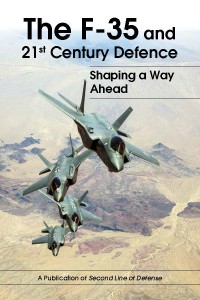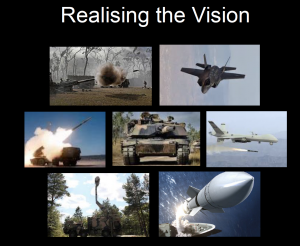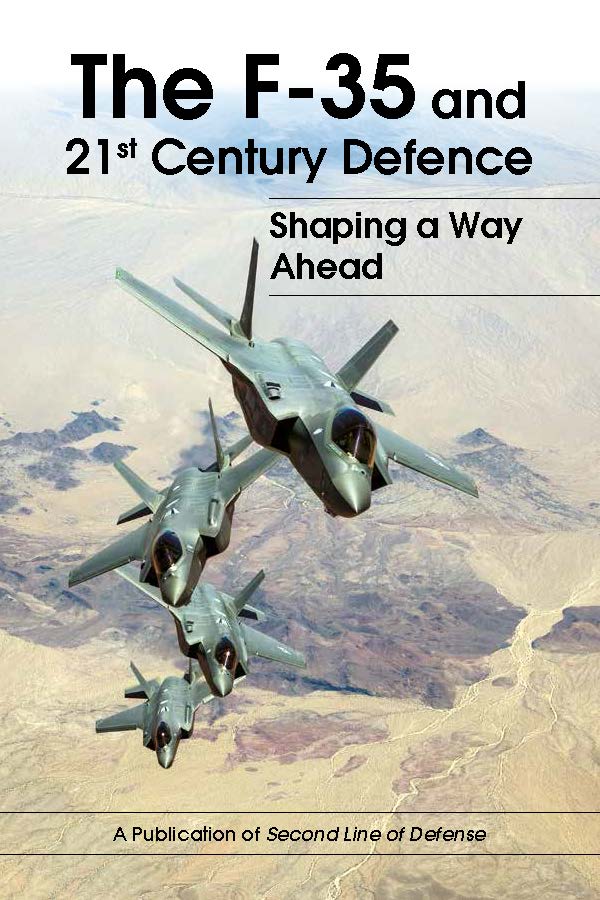2016-05-08
We have published a book on the F-35 and 21st Century Defence: Shaping a Way Ahead.
The book is appearing initially on Amazon and will be available worldwide on Amazon stores in their digital format for reading on Kindle.
The book is about the arrival of the F-35 and its interactive role with other key innovations, which are reshaping the defence forces of the democracies.
As one analyst, put it: “If you did not have the F-35, you would have to invent it to be part of and to further the innovations we are pursuing to reshape defence, combat, and homeland security operations.”
The book draws on literally hundreds of visits with pilots, maintainers, testers, industrialists and visits in Asia, Europe and the Middle East discussing the F-35 and how it is viewed by key states as part of their defence transformation.
The F-35 has arrived.
With more than 50,000 flight hours on the F-35 fleet and an operational squadron with the Marines, and second shortly, to be joined by the USAF this year and the Navy next year, the F-35 fleet has already taken off.
There are currently more than 250 F-35 pilots and 2,400 aircraft maintainers from six nations already trained and more than 110 jets are jointly under construction at the Fort Worth and Cameri production facilities with Japan starting its initial production as well.

The F-35 has become tactically operational in the USMC while the aircraft is undergoing developmental testing by the Pax River and Edwards AFB with an F-35 Integrated Test Force (ITF) for the USAF and USN. What is not widely understood is that the ITF is managing the ongoing developmental testing for the life of the program.
With the scope, complexity and concurrent global reach of the F-35 program, a new approach to testing was set in motion. The program is one of “spiral development” in which combat F-35 Type/Model/Series (T/M/S) airplanes emerge throughout the process to operate as effective combat assets, even while the developmental testing for all three types of F-35s continue.
Put bluntly, the F-35B in the hands of the Marines is a fully “up” combat aircraft (both airframe, sensors and weapon systems) addition to the USMC Air/Ground team.
All Squadron Pilots in Marines, USAF and Navy, will be backed up by the best test community in the world at Edwards and Pax. This partnership forged for decades will continue a dynamic synergistic combat way for the entire life of the F-35 Global Enterprise
For the Lightning II, the past decade of putting together a unique, and innovative approach to shaping the F-35 fleet has paid off and has built a solid foundation for the decade ahead.
As U.S. fighter pilots and their partners generate fleet and ultimately combat experience that will lead to never ending innovations and developmental testing.
Put bluntly, if you waiting for the end of developmental testing come back in 30-40 years. Meanwhile, the F-35 fleet will have reshaped air combat operations.
The global enterprise is a key part of what happens at Pax River.
The UK is an integral part of the team, and as Gordon Stewart, UK MoD flight engineer at Pax described this powerful and productive partnership:
This is the most integrated test team I have ever worked on. As we work the way ahead, it might be a UK person, a Lockheed person, or a US government person who provides the best solution. It is a very well integrated team at the working level.
It is a very different test process than in the past, although what is happening in the F-35 program is the way we are approaching the future as well. In the past, there was much more serial testing.
Twenty years ago when I first started, the contractor would do something and then throw it over the fence to the government, which would look at it, approve it and then pass it on to the operator.
Now with the pace of technology, and the role of software, we have a much more integrated process. We are shaping the evolution of the aircraft as it goes out the door as well.
At Pax, we are testing a software version ahead or a couple ahead of what the fleet is getting at the moment. In effect, we are testing the next iteration of the aircraft.
And the Edwards and Beaufort efforts provide important pieces to the evolution as well. We have an integrated RAF and Royal Navy team at Edwards. 17 (R) squadron at Edwards is a mix of RAF and RN.
At Beaufort, we have a UK team and one of our aircraft, and we are working closely with the USMC. That is another key element of the joint integrated effort, from our point of view.
In an historic first there was no clearer example of the global nature of the program when the first F-35 to fly across the Atlantic landed at Pax River.
At 1430 on February 5, 2016, the first Italian made F-35A flew into the pattern at Patuxent River Naval Air Station, Maryland and touched down.
The Italian AF pilot call-sign “Ninja” had only flown the jet for 50 hours previous to his seven hour trans-Atlantic dead of winter flight. And most amazing for reliability the airplane, which was the first built in Italy itself, had only 15 flight hours prior to the trans-Atlantic flight completed the entire mission “up and up” with no “gripes” or maintenance problems.
The landing of AF-01, which flew first in Italy in September, was by one of the Italian pilots trained at Luke AFB in the Fall 2015 with a first flight in November, highlighted the progress of the program.
Historically, allies and partners who operate U.S.-generated fighter aircraft would do so sequentially over time as the type/model/series progressed, with U.S. fighter pilots flying the newest jets first and then allies next as production was generated off of U.S. lines.
For example, the first flight by the U.S. of the F-16 was in 1977, however, it took until 2001 for the first USAF F-16s to be introduced into the Italian AF. Under the terms of a USAF and Italian Air Force agreement named the “Peace Caesar” program was the lease of F-16s to make up for shortfalls in Typhoons in the Italian Air Force fleet.
Put in blunt terms, the Italians are flying the most advanced U.S. combat jet in current production at the same time as the U.S. services.
This provides a unique moment in history and a clear opportunity for shaping new global capabilities.
A key aspect of the global nature of the program is the ability of the fighter pilots of different services and nations to share experiences. With regard to the transatlantic flight, Ninja commented:
I talked with the Marines about their flight – they went from Yuma to Pax – and their flight plan to come over in 2014. They were very helpful. Semper Fidelis is what I have to say about that.
Ninja also underscored that the advantage of learning to operate the aircraft from the ground up was an opportunity to shape new combat approaches as with all members of the first-ever concurrent state-of-the art international fighter program.
Training, Tactics and Procedures (TTPs) will be applied critiqued and modified over and over bay all Air warriors in the F-35 global consortium. Diversity of experiences can lead to unity of purpose to always have the best TTPs to fight and win in air combat.
https://sldinfo.com/lessons-learned-at-pax-river-the-coming-of-the-f-35-fleet/
Recently, in a presentation in Australia, Lt. General Davis, the Deputy Commandant of Aviation for the USMC told an international audience at a seminar Australia, how the F-35 was already a key part of the Marines shaping their way ahead.
“Now that it is in the hands of Marines, they are innovating in ways which the leadership really did not anticipate and much more rapidly than might be imagined.
He described an event where the Commandant was going witness a Yuma to Nellis scenario in which F-35s would be used to support Marines in the maneuver space.
He went to the Marines working the exercise and asked: “Was everything ready for the Commandant?”
The answer was: “Sir we are not going to do exactly what you asked for and are not ready to do it that way?”
Davis commented: “The Commandant is just about here, what are you talking about?”
The Marine answered: “Frankly, the scenario you suggested was not tough enough for we wanted to take our F-35s into a more advanced SAM belt to get through and then support the Marines on the ground.”
Davis was a bit taken aback, but the innovation already evident by the squadron pilots was rewarded with a demonstrated success on the Nellis ranges.
The Commandant was impressed, and although a ground combat Marine, he argued “we need to get that plane into the hands of Marines as fast as we can.”
https://sldinfo.com/the-deputy-commandant-of-aviation-down-under-plan-jericho-marine-corps-style/
No partner has been clearer about the central role of the F-35 in defence transformation than has been Australia.
The Aussies have stood up a newly enabled Air Force, and are working the Air, Naval and ground sides to provide for both the kind of homeland defence, and extended perimeter defence which they see as crucial to their national survival and security.
The Williams Foundation in Australia has led the effort to look at what they are calling fifth-generated enabled defence or combat operations, and throughout are looking at the interactive dynamics of change associated with rebuilding their force as the F-35 comes into the force.
https://sldinfo.com/the-renorming-of-airpower-the-f-35-arrives-into-the-combat-force-2-1/
https://sldinfo.com/plan-jericho-the-raaf-shapes-a-transformation-strategy-2/
https://sldinfo.com/integrating-innovative-airpower-a-report-from-the-copenhagen-airpower-symposium/
As the Air Commander Australia, Air Vice-Marshal Turnbull put it in a recent interview:
“The F-35 clearly is about decision-making and ISR but we are not waiting for the plane to show up before we reshape our ability to use fused data and to push information to the right people at the right time in order to make the right decisions.
I’m thinking about decision making in the cockpit back to the strategic level, but teaching the JSF pilot how to operate in the decision space where he can be a decision-maker, that’s what we need to do as well to shape an ability to get better decisions at the point of attack or defence.
And we are focused throughout the force on how to work the shift forward to the operational level most capable of achieving the desired effect.”
And this is not simply the position of Air Force; it is the position of Army and Navy as well.
For example, Brigadier General Mills, Director General, Army Modernization made a recent presentation at the latest Williams Foundation conference, which highlighted how he saw the F-35 as part of the transformation necessary for the joint land force as the Aussies, call it.
During the briefing, Mills included a slide which would not appear in a typical Army briefing, for in this slide, the F-35 and naval fire support were prominently highlighted.

“Question: You put up a slide, which highlighted a very comprehensive look at joint fires and support to the ground maneuver forces.
How do you view the way ahead?
BG Mills: We need to move beyond the label of air land integration and look at joint integration or multi-domain integration.
We need to focus on the reality of what it looks like at the small team, combat team level, with regard to multi-domain integration with joint effects from JSF or from the Air Destroyer or from overhead surveillance systems.
I think the reality is that as we move beyond this decade, those type of joint effects need to empower the small team to achieve tactical success as the array of tactical successes transcend into an operational impact.
So a number of what would be seen as operational effects I think in the fullness of time will transcend all the way down to the small team, combat team level.
Hence, when a combat team commander who is about to attack a city block can potentially compartmentalize all the electronic emissions going out from that block to know exactly where the threat is.
Then he can look at a whole range of joint fires both lethal and non-lethal to support them in achieving their objectives.”
Mills then added:
“You now need the ability to coordinate direct air land integration fires and you need more F-35 support to deliver that effect.
The reality is that we potentially need to look at as we move beyond this decade of pushing support further down from division level and making it more readily available and more dynamically available to the small group level.
The time responsiveness of an Air Tasking Order that’s 72 hours old is really not going to make it.
I would suggest that time line needs to be radically truncated.
The Chief of Army made the point at the Airpower Conference that in many ways we are still using procedures and approaches that go back to World War II for air-ground operations; this makes no sense in terms of technological advances and operational shifts.
We need to shape a 21st century approach.”
In the first section, we will look at the intersection between the arrival of the F-35 and innovation and transformation of defence capabilities and approaches.
In the second section, we will look at some of the key elements in the F-35 global enterprise which will see an unique arrival of an entire global interactive fleet of users, who can work with one another to meet homeland defence, extended perimeter defence, or expeditionary operations as needed by the leadership of that particular F-35 partner state.
The reach of the F-35 as a data sharing and decision making asset is unprecedented in combat history.
In the third section, we look briefly at some elements of the evolving strategic environment within which the F-35 can provide some solution sets, which can enhance the capability for national defence or embedded coalition capabilities which can empower a diversity of coalitions in the defence of the homeland or in extended perimeter defence.
In short, the F-35 is here now.
And key partners are already rethinking how they will use the plane based on direct engagement in the development, production, training, flying or maintaining the aircraft today.
A very clear look at the way ahead was articulated by the current Chief of Staff of the Royal Australian Air Force, Air Marshal Davies:
“It is like a jig saw puzzle.
You have these really nice pieces to the puzzle sitting in the container, but until you begin to look at the picture your trying to create through the overall puzzle, you do not know which bit goes where.”
With regard to F-35 as an example, Davies argued the following:
“I think Joint Strike Fighter on its own, a fifth generation air combat aircraft, could be regarded as just an air combat aircraft.
If you want to shoot the bad guy down, if you want to defend the battle space for a land maneuver or for a maritime strike, that’s fine.
But what we’re beginning to appreciate now is that it’s not just an air combat asset it is also an ISR node.
If you were to then put two more pieces of your puzzle down and go, “Well that’s starting to form a bit of a picture here,” in the center of your puzzle. ”
What else could I do if it was truly an ISR node?
How do I manage that asset differently than if it was just going to shoot down another fighter?”
Although the puzzle analogy suggested an overall approach what he really was focusing on the interaction between the evolving bigger picture, and relooking at what each piece of the puzzle might be able to do in fitting into a new puzzle big picture so to speak.
“How would you operate the air warfare destroyer differently as you add a Wedgetail, a P-8, a Triton or an F-35 to its operational environment?
And conversely, how could the changes in how the destroyer would operate as you evolve systems on it, affect how you operate or modernize the other pieces of the evolving puzzle?”


